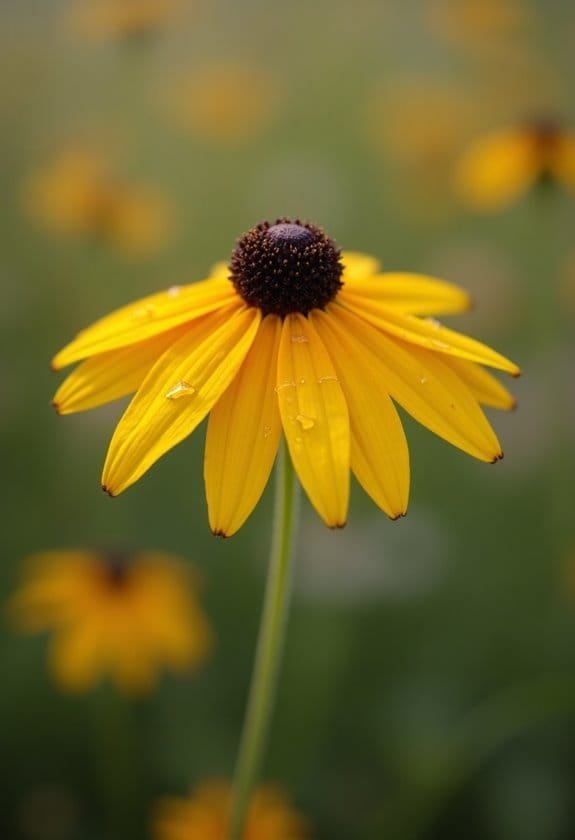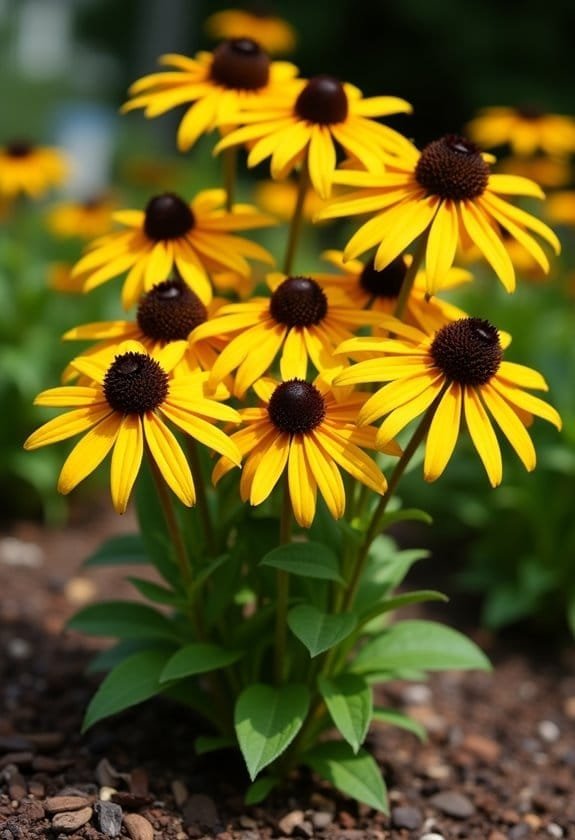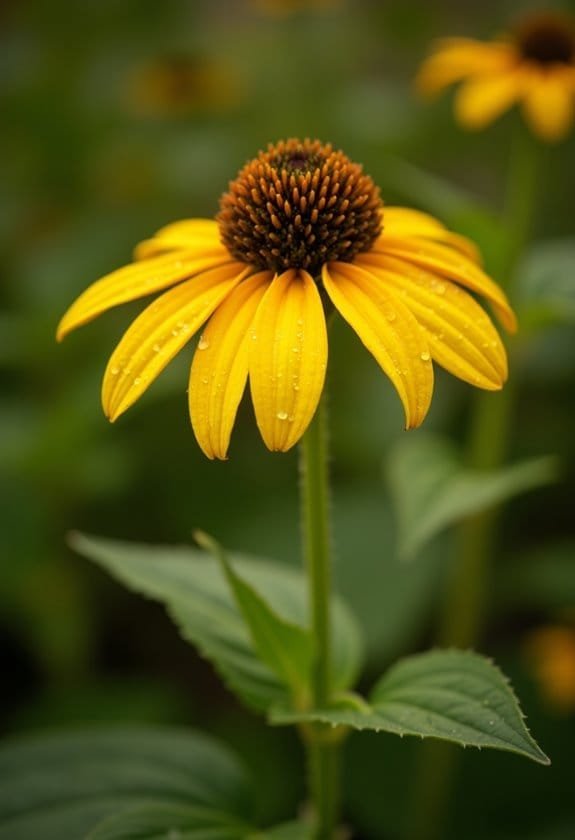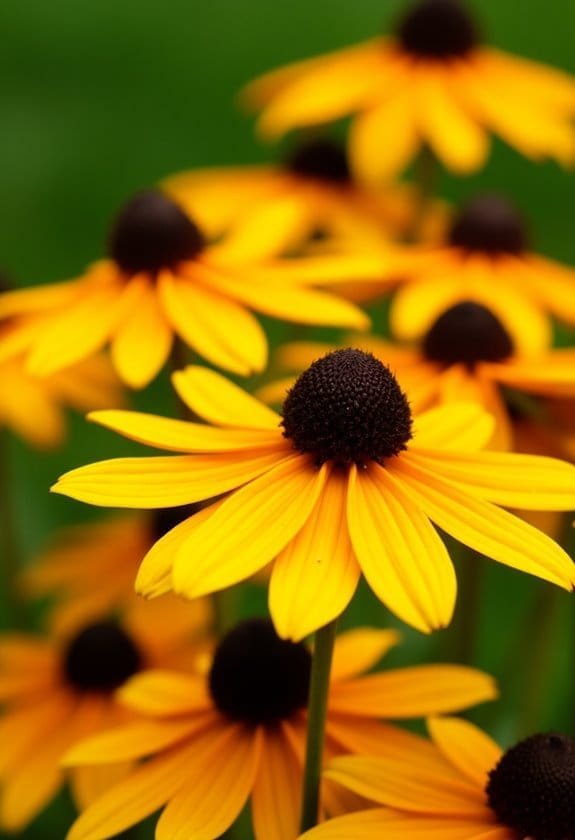Rudbeckia species, commonly known as coneflowers or black-eyed Susans, are resilient perennials in the Asteraceae family that showcase distinctive daisy-like blooms with dark central cones. These eye-catching plants grow between 50 cm to 3 meters tall and thrive in USDA zones 3-9, requiring full sunlight and well-draining soil. Their vibrant yellow to orange ray florets bloom from June through October, serving as crucial nectar sources for pollinators like bees and butterflies. While naturally deer-resistant, they can face challenges from powdery mildew and Japanese beetles, though proper spacing and care techniques guarantee these garden favorites flourish with minimal maintenance. Discovering their specific varieties reveals even more remarkable characteristics.
Main Points
- Rudbeckia species are hardy perennial flowers featuring daisy-like blooms with dark central cones and yellow ray florets.
- Coneflowers thrive in USDA zones 3-9, requiring full sunlight and well-draining soil for optimal growth and flowering.
- Most Rudbeckia varieties bloom from summer through fall, providing essential nectar for bees, butterflies, and other pollinators.
- These deer-resistant plants range from 50 cm to 3 meters tall, making them versatile choices for various garden designs.
- Common varieties include Rudbeckia hirta (Black-eyed Susan), Rudbeckia laciniata (Cutleaf Coneflower), and Rudbeckia fulgida (Orange Coneflower).
Introduction

Rudbeckia, commonly known as coneflowers or black-eyed Susans, stands among North America's most recognizable native flowering plants.
These hardy perennials, belonging to the Asteraceae family, feature distinctive daisy-like blooms with prominent dark central cones surrounded by bright yellow ray florets.
The genus encompasses roughly 20 species, ranging from compact garden varieties reaching 50 centimeters to towering meadow specimens stretching up to 3 meters in height, making them versatile additions to various landscape designs.
Common Name
Known across gardens and wildflower meadows, coneflowers of the Rudbeckia genus have become a beloved sight in North American landscapes. The most widely recognized common name within this genus belongs to the Black-eyed Susan (Rudbeckia hirta), whose distinctive dark centers surrounded by golden petals have captured gardeners' attention for generations.
Among the diverse members of this genus, several species have earned descriptive common names that reflect their unique characteristics. The Cutleaf Coneflower (Rudbeckia laciniata), for instance, derives its name from its deeply divided foliage, while the Sweet Coneflower (Rudbeckia subtomentosa) earned its moniker from its subtle fragrance.
These common names often serve as practical identifiers, helping gardeners and naturalists distinguish between the approximately 20 species within the genus. While botanical names remain essential for scientific accuracy, these familiar monikers have helped popularize Rudbeckia species among home gardeners and landscape designers.
The term "coneflower" itself references the distinctive raised central disk that characterizes all members of the genus, creating a cone-like prominence that serves as both an aesthetic feature and a functional landing platform for pollinators.
Scientific Name
The scientific nomenclature of these beloved garden flowers centers on the genus Rudbeckia, a member of the sprawling Asteraceae family that includes daisies, sunflowers, and asters. This taxonomic classification encompasses numerous species, each displaying the characteristic daisy-like blooms that have made the genus instantly recognizable across North America.
Within the Asteraceae family, Rudbeckia stands out as a distinctly North American genus, with several prominent species illustrating its diversity. Notable examples include Rudbeckia hirta, commonly known as Black-eyed Susan, Rudbeckia laciniata, the Cutleaf Coneflower, and Rudbeckia fulgida, recognized as Orange Coneflower.
Each species name provides insight into the plant's physical characteristics or historical significance within botanical literature.
The genus designation honors Swedish botanist Olaus Rudbeck, while specific epithets often describe distinctive features of individual species. For instance, "hirta" refers to the hairy stems and foliage characteristic of Black-eyed Susan, while "laciniata" describes the deeply cut leaves of the Cutleaf Coneflower.
This scientific naming system enables precise identification and classification of these diverse flowering plants.
Overview
Flowering abundantly across North American landscapes, coneflowers in the genus Rudbeckia captivate gardeners and naturalists with their striking yellow petals and prominent dark centers.
These remarkable members of the Asteraceae family comprise approximately 20 distinct species, each contributing its unique characteristics to the genus's diverse portfolio.
Rudbeckia species have established themselves as cornerstone plants in both cultivated gardens and natural settings, with their impressive height range spanning from a modest 50 centimeters to towering specimens reaching 300 centimeters.
While these resilient coneflowers demonstrate a clear preference for sun-drenched locations and well-draining soil conditions, they've proven adaptable enough to flourish in partial shade environments.
Their ecological significance extends beyond mere ornamental value, as they serve as essential nectar sources for various pollinators, including bees and butterflies.
The plants' natural resistance to deer browsing, combined with their vigorous growth patterns, has made them particularly valuable in sustainable landscaping projects.
These adaptable characteristics, paired with their minimal maintenance requirements, have secured Rudbeckia's position as a favored choice among both novice gardeners and experienced horticulturists.
Key Features
Rudbeckia species showcase remarkable diversity in their growth patterns, with heights ranging from compact 2-foot varieties to towering 7-foot specimens like Rudbeckia laciniata.
Their distinctive appearance features vibrant yellow ray florets surrounding dark central discs, creating a striking visual focal point in garden settings throughout the growing season.
These hardy perennials typically bloom from late summer through fall, producing abundant flowers that serve as essential nectar sources for pollinators while maintaining their ornamental appeal even as temperatures begin to drop.
Growth Size
Among the diverse genus of coneflowers, heights can vary dramatically from compact garden varieties to towering specimens. The Black-eyed Susan (Rudbeckia hirta) represents a moderate growth size, typically reaching about one meter in height, making it an ideal choice for middle-ground plantings in garden designs.
At the more impressive end of the scale, the Great Coneflower (Rudbeckia maxima) stands as a demonstration of the genus's versatility, soaring to heights of up to 300 centimeters. The Cutleaf Coneflower positions itself as another tall variety, stretching between 3 to 7 feet and creating dramatic vertical interest in landscape compositions.
For gardeners seeking intermediate options, the Sweet Coneflower offers a balanced solution, achieving heights between 100 to 150 centimeters. The Western Coneflower, with its more modest stature of 100 centimeters, provides an excellent choice for spaces where height control is essential.
These varying growth sizes, coupled with the plants' herbaceous and perennial nature, allow gardeners to create layered, dynamic landscapes that can accommodate different spatial requirements and design preferences.
Appearance
Beyond their impressive size variations, these garden favorites showcase signature visual elements that make them instantly recognizable. The most striking feature of Rudbeckia species is their distinctive daisy-like flower heads, which display vibrant yellow flowers arranged in ray florets surrounding a darker, prominent central disc.
The foliage adds considerable visual interest, with many varieties exhibiting deeply lobed leaves that create an intricate pattern throughout the plant's structure. This architectural element complements the bold flower display and provides textural contrast in garden settings.
During peak blooming season in summer and fall, the plants transform into beacons for pollinators, with species like Rudbeckia subtomentosa producing particularly large, showy blooms.
Perhaps one of their most enduring aesthetic qualities lies in their winter appeal. The cone-shaped seed heads persist long after the petals have faded, creating sculptural silhouettes against winter landscapes.
These structural remnants stand as natural works of art, their geometric forms offering visual interest even during dormant months, while simultaneously serving as food sources for winter wildlife.
Flowering Season
Throughout the growing season, different Rudbeckia species burst into bloom at varying times, creating an extended display that spans from late spring through early fall. The Black-eyed Susan leads the procession, producing its distinctive flowers from June through October, making it one of the longest-blooming varieties in the genus.
As summer progresses, the Great Coneflower takes center stage, displaying its impressive blooms in nutrient-rich soils during mid to late summer. The Sweet Coneflower follows suit, offering its nectar-rich flowers from July to September, becoming a focal point for various pollinating insects during the height of summer.
The flowering season reaches its crescendo with late-blooming varieties such as the Cutleaf Coneflower and Shiny Coneflower, which showcase their blooms from late summer into early fall. The Shiny Coneflower, in particular, extends the seasonal display through September, thriving in sunny locations with consistently moist soil conditions.
This sequential blooming pattern among Rudbeckia species guarantees a continuous display of flowers throughout the growing season, providing sustained visual interest and ecological benefits.
Growing Requirements

Rudbeckia species thrive in conditions that combine full sunlight exposure with well-draining, moisture-retentive soil compositions.
The plants' adaptable nature allows them to flourish in temperatures ranging from USDA zones 3 through 9, making them versatile choices for diverse climate regions across North America.
These robust perennials require consistent moisture during their establishment phase, though they demonstrate remarkable drought tolerance once their root systems have fully developed in the soil matrix.
Light
Sunlight plays an essential role in the success of Rudbeckia species, with most varieties requiring at least 6 hours of direct sun daily for ideal flowering and growth. While these hardy plants demonstrate remarkable adaptability across different light conditions, their performance often correlates directly with sunlight exposure.
The Black-eyed Susan exemplifies this adaptability, thriving in both full sun and partial shade environments, making it an excellent choice for diverse garden locations.
Similarly, the Sweet Coneflower demonstrates considerable versatility, particularly excelling in sunny woodland borders while maintaining robust growth in moderately shaded areas.
The Great Coneflower, despite its preference for full sun, exhibits successful development in partial shade conditions, especially when provided with consistent moisture.
The Shiny Coneflower represents a more specialized member of the genus, showing a distinct predilection for bright, sunny locations near water features.
This combination of abundant light and moisture availability creates prime growing conditions for this particular species, highlighting how different Rudbeckia varieties have evolved to occupy specific ecological niches while maintaining the genus's characteristic resilience.
Soil
When it comes to soil requirements, most Rudbeckia species demonstrate remarkable adaptability while sharing a fundamental need for well-drained growing conditions.
Different varieties within the genus exhibit distinct preferences, with soil moisture being a key differentiating factor in their ideal growing environments.
The Cutleaf Coneflower stands out for its particular affinity for consistently moist, well-draining soil conditions, which support its robust growth and abundant flowering.
In contrast, the versatile Black-eyed Susan showcases impressive resilience, flourishing across a spectrum of soil conditions from medium-wet to relatively dry environments.
The Sweet Coneflower takes a middle ground, preferring moderately moist, enriched soil that provides steady hydration without becoming waterlogged.
While Rudbeckia species can adapt to various soil types, maintaining proper drainage remains essential for preventing root rot and other moisture-related issues.
Standard garden soil typically provides an adequate foundation for most Rudbeckia varieties, though their performance can be enhanced when growing in soil that aligns with their specific moisture preferences.
Water
Maintaining proper water balance goes hand in hand with successful Rudbeckia cultivation, as these resilient plants demonstrate moderate moisture needs while adapting to various conditions.
Their versatile water requirements make them suitable for different garden settings, from consistently moist locations to areas that experience occasional dry spells.
While Rudbeckia species generally thrive in moist soil conditions, specific varieties showcase different tolerance levels. The cutleaf coneflower, for instance, adapts well to wet environments but requires well-draining soil to prevent root deterioration.
Black-eyed Susans display remarkable flexibility, flourishing in both medium-wet and drier conditions, making them particularly valuable for diverse landscape applications.
During active growth periods, these plants benefit from a measured approach to irrigation, where consistent moisture supports robust flowering and development.
Gardeners should maintain even soil moisture without creating waterlogged conditions, which could compromise root health.
This balanced watering strategy proves especially essential during extended dry spells, when supplemental irrigation helps sustain the plants' ornamental appeal and guarantees continuous blooming throughout their growing season.
Temperature
Rudbeckia species exhibit remarkable adaptability across diverse temperature ranges, flourishing particularly well in hardiness zones 3 through 9. These resilient plants demonstrate optimal performance when soil temperature maintains a steady range between 60°F to 70°F (15°C to 21°C), creating an ideal environment for robust root development and vigorous growth.
While coneflowers show impressive tolerance for various climate conditions, they perform best in moderate temperatures where they can receive adequate sunlight exposure. These hardy perennials require a minimum of six hours of direct sunlight daily, though they may benefit from afternoon shade in regions where temperatures consistently soar above their comfort zone.
During periods of elevated heat, maintaining moist soil becomes particularly vital to prevent stress and guarantee continuous blooming.
Though naturally resilient, Rudbeckia species prefer environments that avoid temperature extremes at both ends of the spectrum. In regions prone to severe frost or excessive heat, gardeners should implement protective measures, such as mulching to regulate soil temperature and maintain consistent moisture levels, making sure these adaptable plants continue to thrive throughout the growing season.
Pollinator Criteria
Rudbeckia species attract a diverse array of pollinators, including bees, butterflies, and beetles, thanks to their vibrant, daisy-like blooms and abundant nectar production.
These plants have evolved an accessible flower structure that features open, flat inflorescences, making it remarkably easy for insects to land and gather nutrients.
The extended flowering period from late summer through early fall creates a crucial sustenance bridge for pollinators when other floral resources become scarce, contributing considerably to local ecosystem health and biodiversity.
Attracted Pollinators
A diverse array of pollinators flock to Rudbeckia species, particularly the Black-eyed Susan and Sweet Coneflower varieties. These hardy plants' flowers attract an impressive range of beneficial insects, with their vibrant yellow ray florets serving as natural beacons for foraging pollinators.
During the vital late summer to early fall blooming period, bees and butterflies frequent these blossoms with remarkable consistency. The flowers' abundant nectar and pollen resources support multiple pollinator communities simultaneously, from industrious solitary bees to larger honeybee colonies.
Their adaptability to various soil conditions makes them reliable sustenance providers for local insect populations, while their natural deer resistance guarantees consistent blooming throughout the season.
The timing of Rudbeckia's flowering period is especially significant, as it provides essential nutrition when many pollinator species are preparing for winter dormancy. This strategic blooming window, combined with their high nectar production, positions Rudbeckia species as essential supporters of biodiversity in both garden settings and natural landscapes, creating sustainable habitats that foster healthy pollinator populations year after year.
Pollination Method
The pollination of Rudbeckia species relies on a highly efficient collaborative process between the plants and their winged visitors. The distinctive architecture of these flowers, featuring prominent central discs surrounded by bright petals, serves as a natural landing platform for approaching pollinators, particularly during the critical late summer to early fall blooming period.
When pollinators land on Rudbeckia flowers, they're drawn to the nectar-rich central disc florets, which contain both male and female reproductive structures. As insects move across the flower head collecting nectar, pollen grains adhere to their bodies through specialized surface structures.
The contrasting black central cone of species like Rudbeckia hirta acts as a visual guide, directing pollinators to the most productive feeding areas while ensuring ideal pollen transfer. This intricate pollination mechanism demonstrates remarkable evolutionary adaptation, as the flower's structure perfectly accommodates various pollinator sizes and behaviors.
The process becomes particularly essential during peak flowering seasons when multiple pollinator species, from tiny solitary bees to larger butterflies, simultaneously visit these blooms, creating an interconnected web of plant-pollinator relationships that sustains local ecosystem biodiversity.
Care & Maintenance

Successful cultivation of Rudbeckia species begins with strategic planting in well-drained soil and thoughtful spacing to accommodate their spreading nature.
These resilient perennials thrive with minimal intervention, requiring only regular deadheading of spent blooms and an occasional balanced fertilizer application in early spring.
Rudbeckia's adaptable nature makes them excellent companions for native grasses, Echinacea, and drought-tolerant perennials, creating sustainable garden communities that support local pollinators.
Planting Tips
Growing vibrant Rudbeckia species requires careful attention to basic planting and maintenance needs. These resilient perennials thrive when planted in well-drained, moist soil conditions that mirror their native habitat requirements, particularly during the ideal planting seasons of spring and fall.
To guarantee successful establishment, gardeners should select a location that receives abundant sunlight, as these sun-loving plants require a minimum of six hours of direct exposure daily for peak flowering performance.
While Rudbeckia demonstrates remarkable adaptability to various soil conditions, maintaining consistent moisture levels proves essential for developing robust root systems and promoting prolific blooming cycles.
Division of established clumps every few years serves multiple purposes: it reinvigorates the plants, prevents overcrowding, and provides opportunities for propagation. This process is best undertaken during the cooler months when plants experience less stress.
Gardeners can also opt for seed propagation, though this method requires more patience as plants develop. Whether choosing division or seed propagation, proper spacing of 18-24 inches between plants allows adequate air circulation and room for mature growth, reducing the likelihood of fungal issues while maximizing each plant's visual impact.
Ongoing Care
Maintaining healthy Rudbeckia plants requires minimal effort once they're established, thanks to their naturally resilient nature. These hardy perennials demonstrate remarkable resistance to common garden pests and diseases, making them an ideal choice for both novice and experienced gardeners.
The key to successful ongoing care lies in consistent but measured maintenance practices. Regular deadheading of spent blooms not only maintains the plant's aesthetic appeal but also stimulates continued flowering throughout the growing season.
While Rudbeckias prefer moist soil, they don't require extensive watering once established, though supplemental irrigation becomes necessary during prolonged dry spells.
To prevent these vigorous growers from becoming invasive, gardeners should monitor their spread and divide expanding clumps every few years. This practice not only controls their growth but also rejuvenates the plants and provides opportunities for propagation.
Fertilization needs remain modest, as these adaptable plants thrive in well-drained soils without frequent nutrient supplementation. Their robust constitution allows them to flourish with minimal intervention, making them an excellent choice for sustainable garden designs.
Suggested Companions
Rudbeckia's companion planting strategy enhances both garden aesthetics and plant health through thoughtful combinations. The strategic placement of complementary species creates a harmonious environment where each plant contributes to the overall success of the garden ecosystem.
Echinacea and Salvia, sharing similar cultural requirements, prove to be excellent companion choices that strengthen the garden's resilience.
Ornamental grasses, particularly Panicum virgatum and Schizachyrium scoparium, offer structural contrast while performing the crucial function of soil stabilization around Rudbeckia plantings. The incorporation of towering Helianthus specimens creates an impressive vertical dimension, establishing a naturalistic, layered appearance throughout the growing space.
Ground-level companions like Thymus and Nepeta serve multiple purposes, suppressing unwanted vegetation while maintaining consistent soil moisture levels. The thoughtful integration of pollinator-friendly species such as Monarda and Asclepias greatly enhances the garden's biodiversity, creating a sustainable habitat that supports essential insect populations.
These carefully selected companion plants work in concert with Rudbeckia to establish a thriving, balanced garden environment that benefits both the gardener and local wildlife.
Common Issues
Rudbeckia species face several notable challenges, with powdery mildew emerging as a primary concern in humid environments where air circulation is limited.
Root rot poses a significant threat to these plants when they're subjected to poorly-draining soil conditions, while aggressive spreading through rhizomes can create management difficulties in garden settings.
While generally deer-resistant, these plants may occasionally attract browsing deer during periods of food scarcity, and overcrowding can lead to both diminished blooming and increased vulnerability to various pests and diseases.
Pests/Diseases
Along with their resilient nature, these beloved garden flowers face several common pest and disease challenges. Japanese beetles and aphids rank among the most troublesome pests, with the latter causing significant leaf distortion and weakening the plant's overall vigor through their persistent feeding habits.
In humid conditions, powdery mildew emerges as a particularly aggressive fungal disease, manifesting as distinctive white, powdery patches that gradually spread across the foliage and diminish the plant's importance.
Root rot presents another serious concern, especially in poorly-draining soils where excess moisture creates an ideal environment for pathogenic fungi to thrive and compromise the root system.
Fortunately, many of these pest and disease issues can be effectively managed through proper cultural practices. Maintaining adequate spacing between plants promotes essential air circulation, while careful watering techniques, such as avoiding overhead irrigation, help minimize fungal disease development.
Early detection and prompt intervention often prove critical in preventing these common problems from escalating into severe infestations that could potentially devastate entire Rudbeckia plantings.
Solutions
Successful cultivation of these vibrant garden favorites requires addressing several common challenges head-on. Gardeners can maintain healthy Rudbeckia populations by implementing strategic management techniques that target specific growth concerns.
The most effective solution for controlling aggressive spread involves monitoring rhizome development, particularly in species like Rudbeckia laciniata, which can quickly dominate garden spaces. Regular deadheading not only prevents unwanted self-seeding but also promotes continuous blooming throughout the growing season, making it an essential maintenance practice for these hardy perennials.
Proper spacing between plants serves as a preventive measure against fungal diseases, while careful attention to moist soil conditions helps strike the delicate balance between adequate hydration and potential root rot.
In areas where deer pose a challenge, selecting resistant varieties such as Rudbeckia hirta offers a natural solution without compromising the garden's visual appeal. Gardeners should maintain a consistent monitoring schedule, addressing issues like overcrowding through division every few years and adjusting watering practices based on seasonal conditions and specific soil characteristics.
Summary

The hardy coneflower family of Rudbeckia species showcases about 20 distinct varieties native to North America, ranging from compact garden favorites to towering meadow specimens. Among these, the Black-eyed Susan (Rudbeckia hirta) stands as a quintessential variety, gracing gardens with its golden blooms from June through October and reaching heights of up to one meter.
These adaptable plants demonstrate remarkable versatility in various growing conditions, flourishing in well-drained soils while certain species adapt readily to partial shade and moisture-rich environments.
Their ecological significance extends beyond mere ornamental value, as they serve as crucial waypoints for pollinators and sustenance for diverse wildlife populations. The species' range encompasses both modest specimens of 50 centimeters and impressive stands reaching 300 centimeters, with the Cutleaf Coneflower's deeply lobed foliage creating dramatic vertical interest.
Garden enthusiasts particularly value these resilient perennials for their low-maintenance requirements and natural resistance to deer browsing, making them ideal candidates for both structured gardens and naturalistic meadow settings.


